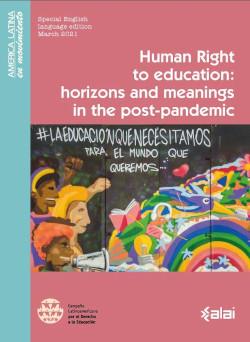The privatization of education
Privatization also involves the absence or relaxation of governmental regulations for the private sector, and the creation of new markets as alternative services to the government.
- Análisis

| Article published in ALAI’s magazine No. 551: Human Right to education: horizons and meanings in the post-pandemic 05/03/2021 |
To begin this dialogue, I consider it fundamental to highlight the unequal nature with which relations in capitalism are presented and constituted. This means that, even though we can identify global trends, the processes of privatization of education occur with particularities in different contexts, since they materialize in locally operated educational policies, which involve actors in historically constructed relations and varying mechanisms of regulation and deregulation of state action in education.
These particularities or singularities are also present among Latin American countries and, sometimes, within the same country. So, in order to analyze and counter the processes of privatization of education in our region, we need to interconnect and learn about the ways in which the privatization of education manifests itself in our countries. Nevertheless, this article will only point out general aspects of these processes.
The challenge here is to systematize the ways in which education can be an object of profit, albeit indirectly. To this end, I refer to the work published in 2018 (Adrião, 2018), in which forms of privatization of education are systematized considering three dimensions of educational policy: public education management, educational supply and curriculum. It is worth remembering that this division stems from a methodological strategy to facilitate recognition of the ways in which education has been privatized, since in educational policy there is a connection between these dimensions.
The meaning attributed to privatization is based on Belfield and Levin (2004), for whom privatization involves processes of transferring activities, assets, and responsibilities from government or public organizations to individuals or private agencies. Privatization also involves the absence or relaxation of governmental regulations for the private sector, and the creation of new markets as alternative services to the government.
Considering the diversity of our region, but taking into account that in most countries the action of the State in providing education, including in the stage of compulsory schooling, more especially in pre-school education, special education and higher education, is not very effective, the privatization of educational supply is a reality and is expanding in this period of the pandemic. Even more so in countries that adopt neoliberal economic policies and budgetary adjustment.
In a general view, I point out two ways that tend to expand at this juncture: public financing (direct or indirect) for educational supply by private providers and the introduction of policies or programs of parental choice.
In the case of direct financing, there is a tendency for governments to establish or expand agreements with private schools, passing on part of the public funds in the form of value per pupil as a response to pressure from school owners in the face of falling family incomes and the consequent decrease in the number of enrollments. Part of the demand is based on statements regarding the impact of school closures on job losses. Indirectly, public funds subsidize private education through the adoption of tax exemptions, as a mechanism to encourage private providers.
A second set of measures that reinforce the subordination of education to profit stems from the introduction, maintenance or expansion of parental choice policies as a mechanism for access to education. Here, I highlight in particular public subsidies for the payment of scholarships in private schools, the adoption of educational credit programs and the introduction or expansion of home-schooling programs. In the first and second cases, public funds are channeled to private organizations that are not always clearly non-profit, while educational credits tend to put families in debt by prioritizing financial market remuneration. Home-based education, on the other hand, deserves an addendum, since even though it is not a mechanism of direct profitability, it mobilizes a huge publishing market, enhanced by technologies and digital platforms during the pandemic.
Distance learning
Considering the capillarity of global communication companies and the subordination of schools and education systems to their tools, as a condition imposed by the adoption of distance learning for a large portion of students and teachers, it is undeniable that the privatization of the curriculum of our schools is advancing. The process of purchasing resources and educational inputs from global corporations and publishers (Clade, 2014; Croso and Magalhães, 2016) and the hiring of private consultants to design and reform curricula, is associated with the adoption of platforms and tools developed by corporations and offered "free of charge" to schools, public education systems and home education practitioners. It is worth mentioning the warning made by Scasserra and Sai (2020, p. 4) for whom:
the problem of large technological companies is not so much the private ownership of data (they could cheerfully say: "the data is yours, the data is of each person, it belongs to you"), but the private ownership of the algorithms, which are the true means by which products (apps) or services (streaming, social networks, segmented or personalized advertising, etc.) are generated, allowing for enormous profit.
Digital platforms and distance learning stimulate yet another "niche" of the education market which are the franchises of private classes or tutoring. Companies in this sector offer the outsourced and casual services of teachers registered on their websites to support children and adolescents, families, or even schools facing a cost containment regime. In higher education, the adoption of remote teaching moderated by "tutors" to replace teachers, a pre-existing practice, also tends to expand.
Finally, privatization of education management is accentuated through the adoption of forms of transfer of school management to private organizations, a policy associated with the reduced direct presence of the state in public education management; and even where non-profit organizations are involved, it tends to generate a market of private providers whose "financial surpluses" are not clearly identified as profit.
The actors
To conclude this dialogue, I would like to point out the actors who foster these privatization processes, taking into account the consent, commitment or omission of the governments. In the first place are transnational corporations, especially technology and communications companies and publishers, in many cases associated with national companies. Secondly, investment funds, especially Venture Capital, which give leverage to educational sector start-ups. A third group is made up of advocacy organizations, which press for the implementation of liberalizing policies and the allocation of public funds to the private sector. A fourth group, the philanthrocapitalists (Bishop and Green, 2008) induce the adoption of educational policies designed by "partners" and sponsor educational reforms that present a return, including financial ones, as a counterpart. Finally, there are the owners of private schools, the entrepreneurs of education, who in the face of the post-pandemic crisis accentuate the dispute for public funds.
In this context, it is essential to reaffirm the need for public funds to be applied directly to public education and for eventual transfers to private institutions to be an exceptional alternative, associated with the commitment of public authorities to apply their resources to expand and qualify their own network. Likewise, there is clearly a need for increased transparency and social control over the allocation of public funds as well as reaffirming the importance of building alternatives to the offer of corporations, undertaken by civil society, universities, schools, unions, etc. Finally, we reaffirm the importance of public educational institutions as a space for meeting and building inclusive and citizen values and practices.
(Translation: ALAI)
Theresa Adrião: Unicamp/Unemat.
References.
ADRIÃO, T. Dimensões e Formas da Privatização da Educação no Brasil: caracterização a partir de mapeamento de produções nacionais e internacionais. Currículo sem fronteiras, v. 18, p. 8-28, 2018
BELFIELD, C and LEVIN, Henry. Education Privatization: Causes, Consequences, and Planning Implications. Paris, UNESCO-IIPE, 2002. https://publications.iiep.unesco.org/Education-privatization-causes-consequences-planning-implications
BISHOP, Matthew; GREEN, Michael. Philanthrocapitalism: How the rich can save the world. Bloomsbury Press. 2008.
CAMPAÑA LATINOAMERICANA POR EL DERECHO A LA EDUCACION (CLADE). Mapeo sobre Tendencias de la Privatización de la Educación en América Latina y el Caribe. São Paulo: CLADE, 2014.
CROSO, Camilla; MAGALHAES, Giovanna Modé. Privatização da educação na América Latina e no Caribe: tendências e riscos para os sistemas públicos de ensino. Educ. Soc., Campinas, v. 37, n. 134, p. 17-33, Mar. 2016.
OECD. netFWD Venture Philanthropy in Development: Dynamics, Challenges and Lessons in the Search for Greater Impact”, OECD Development Centre, Paris, 2014.
SCASSERRA, Sofía Beatriz and SAI, Leonardo Fabián, Fundación Friedrich Ebert. Buenos Aires – Argentina, June 2020.
Del mismo autor
- The privatization of education 03/03/2021
- Privatização da educação: tendências de subordinação ao lucro pós pandemia 11/01/2021
- Privatización de la educación 05/01/2021
Clasificado en
Internet ciudadana, Pandemia
- Nick Bernards 31/03/2022
- Paola Ricaurte 10/03/2022
- Burcu Kilic 03/03/2022
- Shreeja Sen 25/02/2022
- Internet Ciudadana 16/02/2022

